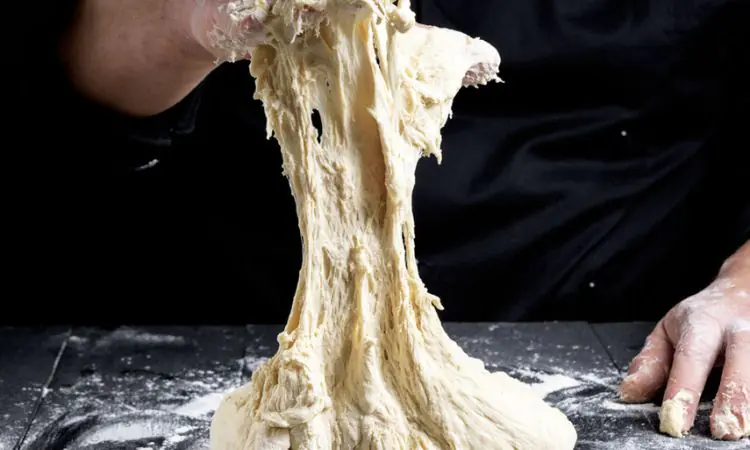Add additional flour, a tablespoon at a time, to the wet pizza dough until it reaches the desired consistency—Knead gently after each addition to incorporate the flour.
Crafting the perfect pizza dough is a culinary balancing act. You set the stage for homemade pizza that rivals your favorite pizzeria with flour, water, yeast, and salt. Yet, it’s common to encounter a dough that needs to be more sticky and wet, a hurdle that can frustrate both novice and seasoned home cooks.
The trick is to avoid panic and understand that wet dough isn’t the end of your pizza dreams—it’s merely a minor setback that’s easily fixed with a bit of extra flour. Quick adjustments will ensure your dough rolls out smoothly, ultimately transforming into the ideal canvas for your sauce, cheese, and toppings. This approach keeps you on track for a delicious, homemade pizza that will impress.

Credit: www.culinaryexploration.eu
The Perils Of Soggy Pizza Dough
Soggy pizza dough turns the joyful experience of homemade pizza into a kitchen nightmare. Facing too-wet dough is more than just stickiness; it compromises texture and flavor. Perfecting the dough is crucial for a crisp base and delicious pizza.
Recognizing Overly Wet Dough
How can you tell if your dough is too wet? Look for these signs:
Common Causes Of Moisture Imbalance
Dough that’s too wet often comes from:
| Cause | Effect |
| Too much water | Makes dough sticky |
| High humidity | Absorbs extra moisture from the air |
| Incorrect flour type | Some flours are less absorbent |
Remember, measuring ingredients accurately is essential. Use a scale for best results. Adjust with flour or water if needed. Always consider the weather when making dough.
Immediate Tactics To Salvage Your Dough
Pizza dough too wet can lead to frustration. Don’t worry; you can still rescue it. Immediate action can turn that sticky mess into the perfect pizza base. Let’s explore some quick fixes.
Adding Flour Gradually
Sprinkle a little flour over your dough. Then, knead it in gently. Keep your movements light. Repeat until the dough feels right. Here’s how:
The Baking Sheet Method
Lay your dough on a floured baking sheet. Use the sheet to fold the dough. This technique traps dry flour in the folds. Keep going until the texture improves. Follow these steps:
Cold Air Exposure Technique
Cool air helps firm up the dough. Place your dough in the fridge for 20-30 minutes. A cooler temperature tightens the gluten strands. This results in a manageable dough. Follow the next steps:
Long-term Adjustments For Perfect Consistency
Mastering the art of pizza dough takes patience and precision. Maintaining perfect consistency isn’t just about quick fixes; it also involves making long-term adjustments. These changes will help you achieve a more reliable dough every time you bake. When the dough is too wet, adding more flour is tempting. However, this solution can lead to inconsistent results. We’ll explore methods to fine-tune your dough over time.
Measuring Ingredients Precisely
The key to consistent pizza dough starts with precise measurements. Invest in a good kitchen scale. Measure ingredients by weight, not volume. This ensures accuracy. Tablespoons and cups can mislead you. Scales cannot.
Adjusting Water Ratio
Different flours absorb water in unique ways. Some may require less water; some may need more. Observe how your dough feels. Sticky? Reduce the water slightly. Crumbly? Add a bit more. Keep notes of these adjustments. Your dough’s consistency will improve.
Controlling Ambient Humidity
Humidity in the air affects your dough. A humid day can make the dough stickier; a dry day does the opposite. Pay attention to the room’s humidity when you bake to manage this. Use a humidifier or dehumidifier if needed. Keep the room at a stable humidity level. This will help create a consistent dough environment.
| Condition | Action | Result |
| High Humidity | Use a dehumidifier | Less sticky dough |
| Low Humidity | Use a humidifier | More pliable dough |

Credit: m.youtube.com
Kneading Know-how For Wet Dough
Dealing with overly wet pizza dough feels challenging. But don’t worry! Proper kneading turns sticky messes into perfect bases for delicious pizzas. With the right kneading techniques, the dough gains the strength it needs. Let’s dive into how to work with a dough that’s too wet.
The Right Technique To Add Structure
Kneading wet pizza dough requires a delicate touch. You can enhance the dough structure without making it too dry. Follow these steps:
As you knead, the dough will become less sticky and more pliable. Add flour sparingly to keep the moisture balance.
Kneading Time Adjustments
When you’re working with wet dough, timing is crucial. Here is how you can adjust your kneading time:
If the dough remains tacky, continue with short bursts of kneading and resting. This method gives wet dough the structure it needs.
Preventing Sticky Situations In Future Bakes
Pizza dough that’s too wet can ruin your baking day. Next time, prevent sticky situations with some easy tips. Bolder flavors and perfect textures await when you master the dough. Let’s dive into the flour and beyond to keep the dough just right.
Selecting The Right Flour Type
Flour is the foundation of pizza dough. Use the right type for a better bake. Different flours absorb water differently:
Remember, the higher the protein, the more water the flour can handle. Measure your flour correctly. Use a scale for accuracy every time.
Proofing Practices And Dough Management
Giving dough the right time to rise makes a big difference. Control moisture with proofing and management:
Use a timer to track proofing time. Don’t rush it. Good dough takes patience.
Storing Dough The Right Way
Store your dough to keep it from getting too wet:
| Storage Method | Tips |
| Refrigeration | Wrap the dough in plastic. A cold ferment adds flavor and firms it up. |
| Room Temperature | Cover with a damp cloth. Let it rise slowly and steadily. |
| Freezing | Freeze in airtight bags. Thaw in the fridge before use. |
Label your dough with the date. Use it within a few days for best results.

Credit: alexandracooks.com
When To Start Over Recognizing Irreparable Dough
Sometimes pizza dough reaches a point beyond saving. It’s hard to let go of your hard work. Yet, knowing when to start from scratch saves time and trouble. This guide will show you how to identify unsalvageable dough.
Signs Your Dough Can’t Be Saved
If the dough feels soupy, even after adding flour, it’s a red flag. Another bad sign is an odd smell. This could mean over-fermentation. Dough that won’t hold shape after proofing is also past the point of no return. Extreme stickiness, despite kneading, is another sign. Lastly, if the dough rises too long, it might become too weak to use.
Tips For Avoiding Wasted Ingredients
Prevent dough disasters with these tips:
Experimenting is part of the learning process. But these tips ensure fewer mistakes and better pizza.
Frequently Asked Questions On What To Do If Pizza Dough Is Too Wet
How Do You Fix Soggy Pizza Dough?
Preheat your oven with a pizza stone or steel before baking—blot excess moisture from the toppings. Stretch the dough to promote even thickness. Use less sauce and cheese. Bake at the highest temperature for a crispier crust.
How Do You Fix Pizza Dough That Is Too Sticky?
Sprinkle flour onto the dough and knead until the consistency feels right. Add flour gradually, mixing thoroughly, until the stickiness reduces.
How Do You Thicken Pizza Dough?
To thicken pizza dough, increase the flour-to-water ratio by adding small amounts of flour and kneading until reaching the desired consistency.
How Do You Make Pizza Dough Not Wet?
To prevent pizza dough from being wet, measure ingredients accurately, use high-quality flour, and knead thoroughly. Allow the dough to rest, and adjust with extra flour if sticky. Always work on a floured surface to manage stickiness.
Conclusion
Tackling wet pizza dough doesn’t have to be daunting. Remember, flour, patience, and proper technique are your allies. By applying these tips, you’ll ensure your dough reaches the perfect consistency. So, roll up your sleeves and transform that sticky mixture into a delectable pizza base that’s sure to impress.

As the author of the “Ultimate Pizza Guide: Recipes, Tips & Secrets Revealed,” I’m dedicated to sharing my love for pizza and empowering others to create delicious homemade pizzas with ease. Join me on a journey to uncover the secrets to perfecting your pizza game!



